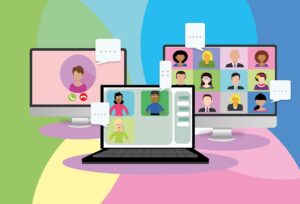
Digital tools and technologies shape the way we teach and the way we learn. During the Pandemic we became adept at communicating, and collaborating online. From joining Zoom or Google Meet classrooms we learned how to join breakout rooms, chat, and learn online. Today there is an increase in online courses and virtual or hybrid classrooms. Digital tools encourage collaboration and students are able to co-create, or collaboratively brainstorm, share ideas, and images through shared Google Docs, Slides or Jamboard. Technology allows students to create podcasts, videos, or digital texts/art. Technology automates tasks. Google Forms grade quizzes. AI can be used to personalize learning and adapt resources. While I am building my skill set in this area some of the teachers at my school adjust texts with AI to match reading levels. AI can also be used to generate rubrics, or even lesson ideas. Lesson delivery can be made interactive with live polling and quizzing using digital tools like kahoot, Wayground (formerly Quizizz), Mentimeter, or Blooket. Technology expands access to resources from joining virtual field trips, to accessing online libraries. Digital tools also help organize and online calendars like Google Calendar or Edsby allow students to plan ahead, while also allowing teachers to coordinate and communicate expectations. In the article, Understanding the role of digital technologies in education: A review the authors detail 34 applications of technology in education. In summary the authors argue that instructors must incorporate technology or face marginalization. At first I thought that was a bit extreme having survived an old school education, but I can see how if you were not using digital tools and technology to communicate with parents, to enter grades, submit data, and complete report cards you may be made redundant.
Digital technologies assist in developing abilities that will require students’ professional performance, such as problem-solving, thinking structure creation, and process comprehension. They are also preparing for a more unpredictable and changing future in which technology will play a critical role. Students’ acquired qualities and abilities will be essential to their professional success. Educational resources and digital tools help to improve the classroom atmosphere and make the teaching-learning process more compelling.
One way to make the teaching-learning process more engaging is through the use of memes. In the article, Enhancing the student learning experience through memes, the authors detail a project where students were asked to reflect on their learning and produce a meme. Participants used a Meme Generator and shared their Memes in real time through Padlet. Students reflected on the activity in a word cloud. Engaging, Interesting, Creative and Different stood out and validate that using/making memes was both positive and enjoyable as a learning experience. The authors conclude that meme-making is an engaging way to have students reflect. As it is both fun and relevant students will retain class content.
In an era where class participation can be difficult, this method demonstrates that as educators we need to innovate in our approaches and consider trying new methods for engagement, even when they are not within our own cultural experiences.
 Occasionally I have used memes in the classroom to introduce humour into otherwise routine topics like classroom expectations. Memes can provide an entry point for discussion rather than just listing rules, and it can also make the expectations memorable, set a positive tone, and capture student’s attention. I think it would be interesting to have students in my class make memes to encourage engaging critically with content.
Occasionally I have used memes in the classroom to introduce humour into otherwise routine topics like classroom expectations. Memes can provide an entry point for discussion rather than just listing rules, and it can also make the expectations memorable, set a positive tone, and capture student’s attention. I think it would be interesting to have students in my class make memes to encourage engaging critically with content.
In a lecture given on October 6, 2025 Dr. Hildebrandt speaks of shifts in technology. One of these shifts she speaks of is access to content. Immediate access has changed how we engage with content. Another shift is the change in tools available. Now many of our students have access to their own personal devices and are actively posting on various social media platforms. These shifts have caused a change in relationships. Through sharing and creating Memes, TikTok‘s, SnapChats culture is being shaped. Henry Jenkins describes participatory culture where we have the capacity to produce and share media. By tapping into the desire to play with media and technology he encourages educators to see this as an opportunity to prepare students to recognize their role in contributing to and shaping culture. He provides an example of having students change a Wikipedia entry, to have their entries be tested and back their arguments up with evidence. These students were empowered by participating.
Henry Jenkins also advocates for educators to equip students with the tools to engage with content and communities online.
Dr. Hildebrandt spoke of the challenge of digital and participatory culture being the lack of mediation. Participatory culture invites anyone to join the conversation. This can lead to challenges including misinformation, with bots automating harmful or misleading content. Echo chambers and algorithms can limit perspectives. Superficial participation of liking, commenting and sharing do not replace meaningful interactions. Remixing, reposting and sharing blur copyright and ownership. Other concerns might include privacy and curated online selves seeking validation in unhealthy ways. How do we help our students critically navigate digital content?
I am reminded of a conversation I had with my class the other day where we discussed sources in their research. There were some gasps when I said google might not have the right answer and then showed them the google answer versus another response from the Canadian Encyclopedia online. Not everything on the internet is true. Recognizing that there is fake news, bias, questioning sources, thinking about what we are seeing and asking questions can be steps toward building critical media awareness. Charlie Gedeon compares this experience of using Google to ChatGpt and the magical allure of the first result. He speaks to the importance of having students study myths and disinformation. While it may seem all doom and gloom that AI is making us dumber, as we offload our learning, perhaps by analyzing responses, comparing and verifying sources, uncovering bias and voice, assumptions, and asking better questions we can enable students to critically participate in this digital culture.
Hi Rhonda!
Thank you for such a thoughtful and engaging post! With everyone so dependent on the online world, it is more important than ever that students learn how to engage with it properly. Sometimes I even have moments myself where I have to stop myself, pause, and think critically, instead of just going “let’s see what Google says”. I know you mentioned that you’ve had a conversation with your students about the first search on Google not always being accurate. What are some other ways you are trying to build digital awareness in your classroom?
I don’t know that I have really been intentional in building digital awareness. I am more aware that I probably should be after taking this class. Mostly it is just in the everyday use of computers. For example this might be a conversation about keeping their passwords private. I generally make their passwords for the students in grade 5 and for some it is the first time they have had a login and password for a computer. Inevitably someone gets into someone else’s account and changes something or plays with their settings and we have to have a conversation about keeping passwords private again. We start the year with conversations about what to post on the landing page of our Google Classroom. What they post online is lasting and public. I model and discuss online respectful communication.
Occasionally I may have a lesson, where it fits, on fact checking strategies, or using reputable sites, evaluating websites or bias, or citing sources. When students are making Canva or Google Slide presentations they need to include a slide citing sources and giving credit for images, music or text.
Do you have conversations with your students to build digital awareness? I would be curious about what teachers are doing that teach students younger than grade 5 about being safe online.